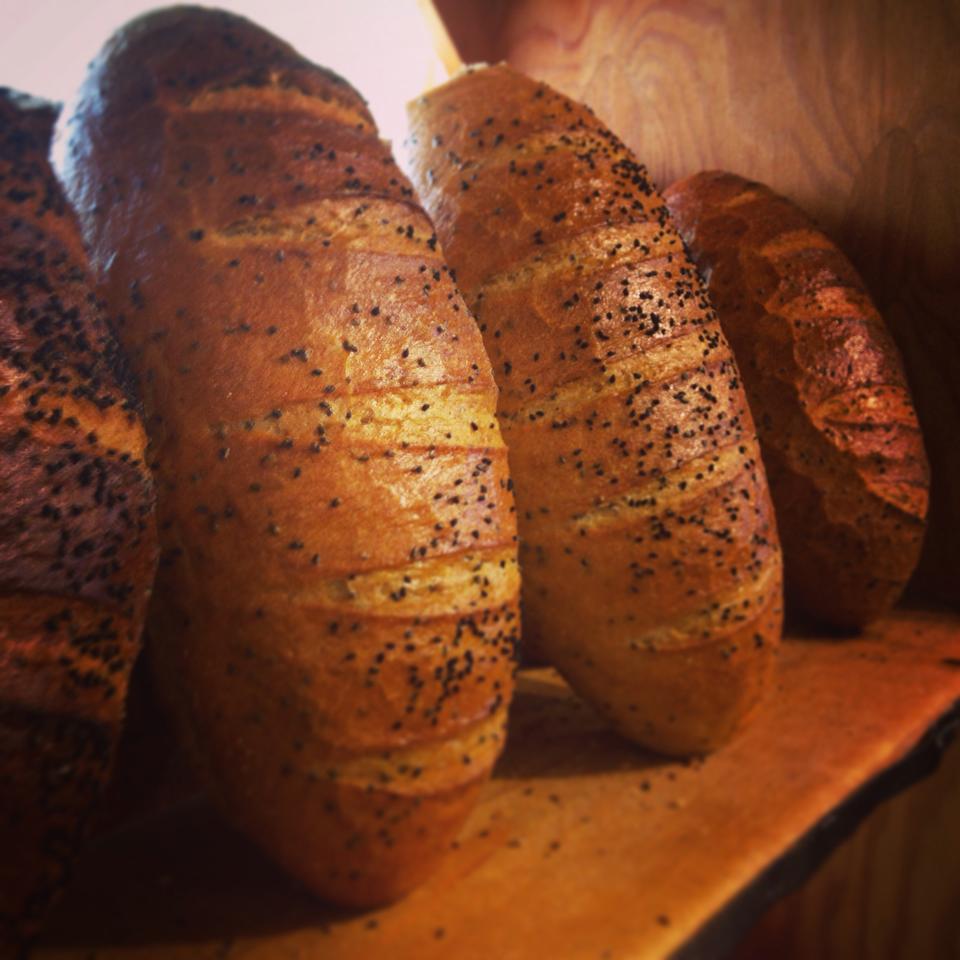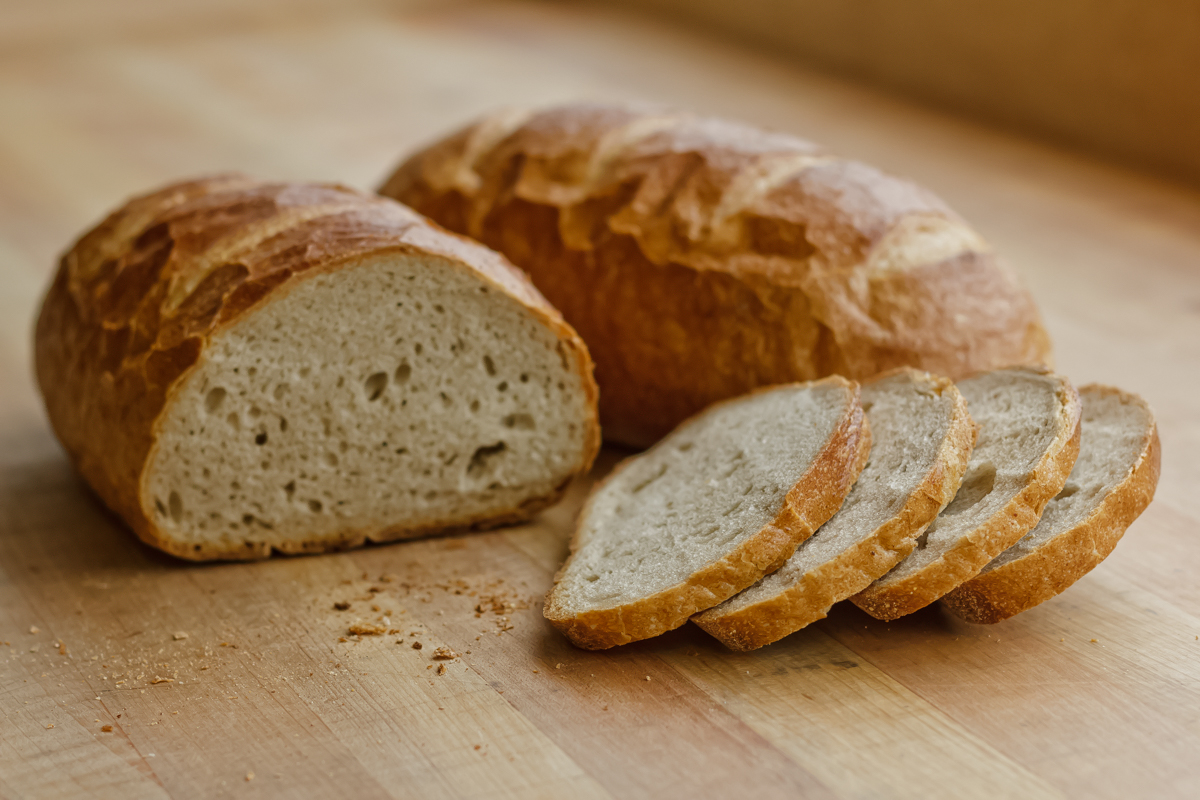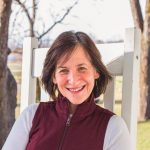Rye bread occupies two very different parts of my life—the professional world of artisan baking where we have baked Jewish rye bread and pumpernickel at Zingerman’s Bakehouse daily for the last 21 years along and often bake German and French rye loaves; and my personal ethnic identity and family culture which includes Jewish cuisine.
I was born in Sydney, Nova Scotia, a former coal mining and steel town of 35,000 or so (it’s been a diminishing population for as long as I can remember), on the beautiful and relatively remote island of Cape Breton in far eastern Canada. Go ahead and ask, everyone does: Were there really Jewish families there? Yes, there were. A community started there in the 19th century and continues to this day. During my early childhood the synagogue was thriving and the center of religious and community life for about one hundred families. By the time I was a teenager, the 1980s, however, the community was clearly struggling and is now significantly diminished. My generation left for more promising opportunities mainly in Halifax, the capital of the province, and Toronto.

My family ate traditional Ashkenazi Jewish foods mostly during the Jewish holidays. Gefilte fish, chopped liver, matzah ball soup, brisket, tsimmes, and mandelbread were all familiar fare. At non-holiday times, a guest would know our ethnicity from the bagels, lox and pickled herring we ate at every Sunday brunch, the Montreal smoked meat we warmed for Saturday lunch and ate on the fresh rye and pumpernickel we’d picked up after Saturday services. The prevalence of pickles and horseradish may have also been a clue that we weren’t Irish or Scottish, the primary heritage of most of the rest of the community.
Rye and pumpernickel brings us to the other center of Jewish life in Sydney, the place where we could buy some of this food—Ike and Tootsie’s Delicatessen. I just love saying that—Ike and Tootsie’s. Who calls anyone Tootsie anymore? I don’t even know what the official name of the delicatessen was. We just referred to it as Ike’s and we’d go there every Saturday after Synagogue. My mother would pick us up after Saturday morning services. We’d head over to Ike’s to pick up fresh bread, often still warm: rye, pumpernickel and what we called French. My mother bought more than we really needed because we often managed to eat half of each loaf during the drive home. Warm bread is irresistible in almost any form! My thoughts about rye bread are as much about visiting this deli as they are about actually eating the bread.
Ike’s was a tiny store, very old world in its atmosphere, packed with items, just like the stalls I have visited in Middle Eastern markets. In keeping with earlier times, Ike and Tootsie and their two children lived above the store. Live above the store? That seemed both exotic and mysterious to me. I preferred visiting when the store was busy because it gave me time to explore. I didn’t complain about the extra time it took for Tootsie to whisper gossipy news to my mother. I loved seeing the foreign languages on the labels and peering through the glass jars trying to figure out what was in them. I first discovered panettone, halvah and artichokes in this store. The smell of the store intrigued me too. It was a mix of spices and pickle brine, olives…and probably a little dust, because not so many people in Sydney bought these unusual things, so they sat on the shelves for a long time. Each week I’d look carefully to see if something new had come in or if a jar had been sold.
But back to rye bread: Sydney Nova Scotia, Canada in the 1970s was very far away from the origins of the Jewish rye eating tradition. I wondered as a child why we ate this strong and foreign tasting bread while my predominantly Catholic Scottish and Irish friends knew nothing about it. I understood that as Jews this is what we ate… but why? I wondered what it had to do with us? The answers to these questions came much later in my life when as a professional baker I began to explore the history of grains and styles of bread.

A Little History of Rye
Rye has never been the most popular of grains and has definitely taken second place to wheat and barley in world history. The rye plant was a wild weed in ancient Mesopotamia, the original bread basket of the world, and there is some evidence that it was domesticated and grown intermittently before wheat and barley became the predominant grains there. Growing conditions are much more favorable for rye in northern Europe where it is cooler and wetter, and it’s believed that it was domesticated there around 1,000 BCE. The first written records of rye cultivation were by the Roman naturalist Pliny the Elder around c. 77 CE. He noted that it was grown around the Alps and commented that it was “a very poor food and good only to avert starvation.”
In more recent times, rye has been grown widely in northern Europe and Russia. Rye is a weed that grows with wheat and was harvested and reseeded with wheat even when farmers didn’t really want it. Interestingly, rye and wheat were often harvested and ground together and the resulting flour was called maslin in English or shitnitse in Yiddish.1 This was the primary form of flour in northern Europe well into the 19th century. It was grown as far south as Romania, the most southern reaches of Ashkenazi culture, where corn was the predominant grain. There it was sometimes ground with split peas or barley also. So the Ashkenazi Jews of Eastern Europe were very familiar with rye while Sephardic Jews were not at all.
Maslin is a key to the history of rye bread. Having the rye and the wheat mixed together was actually fortunate, even if unintended, for the baker and in my mind the eater. Both wheat and rye have gluten; gluten strands are formed in bread and stretch to hold the carbon dioxide given off by yeast. This results in loft and holes in the crumb of the bread, so gluten allows for a lightness in bread. Since rye has less gluten, a loaf made from 100% rye is very dense. The mixture of wheat and rye in maslin allows the gluten of the wheat to create a more pleasing texture in the bread. Most Jewish rye breads made in the United States today are primarily wheat with a little rye.
Back to history. The original rye bread of northern Europe was either kornbrot, korn being the Yiddish word for rye, or schwarzbrot (black bread). (It is still possible to find a bakery in the United States today referring to the rye bread as korn bread. Of course this confuses most Americans who don’t know any of the history and wonder what corn has to do with the bread they’re eating.) The differences between the two breads had to do with how refined the rye was and how much wheat flour was added to it. Most daily bread of the Jews in Eastern Europe had very little wheat in it because of the expense. The poorer the community, the darker the bread. Sometimes caraway or chernushka (nigella seeds) was added to the bread, adding some additional flavor to what otherwise is a relatively mild-tasting grain. Most Americans think that rye has a very strong flavor but that’s really the caraway that is often added to the dough not the rye itself.
Jewish rye bread was made from a sour rye starter called roshtshine. Before the mid-19th century, all breads were made with sour starters. To add color, moistness and a deeper flavor, bakers used an altus or alte brot, old bread. I believe that this was also an economic strategy—a way to use unsellable bread rather than to waste it or feed it to animals. It has also been suggested that this was a symbolic religious gesture of maintaining the circle of life by adding some of yesterday’s bread to today’s. The bakers generally made large rounds or ovals weighing many pounds. They were then sold by weight, in pieces. Before placing the loaves in the wood-fired ovens, bakers would make a glaze of sifted rye flour and water. The effect was a slightly lighter and shiny crust relative to an unglazed loaf. This glaze was called kharmushke.
The bread was eaten in chunks or slices as an accompaniment to the other foods on a person’s plate. It may have been schmeared with chicken schmaltz and eaten with herring and onions on a good day, and with meat or chopped liver on a more special day. These traditions were brought to the United States in the mid-nineteenth century where they evolved to what I became familiar with in my childhood. German, Polish, and Russian bakers continued to make a tangy rye bread using a starter and a combination of rye flour and the much more common and not nearly as expensive wheat flour. Add some commercial yeast to the mix and we can now see what was then coined and lives on as Jewish Rye – the bread of Jewish deli sandwiches.

Rye bread at Zingerman’s Bakehouse
I discovered some of this history and solved my childhood mystery of “why rye?” in the early 1990s when we opened Zingerman’s Bakehouse. The Bakehouse was created initially to make bread for Zingerman’s Delicatessen. The most important breads we needed to master were Jewish Rye in all its forms—seeded, not seeded, chernuska and tsitsel (a round loaf with a slit in the top made from a caraway-free dough; the Yiddish word means “breast”) and pumpernickel. The process we chose to follow is remarkably similar to the method of our old world forbears.
In September 1992, we created a rye sour just like the Jewish bakers of Poland and Russia had 200 years earlier. We have fed and fermented this same sour every day since then. We mixed rye flour with water and put raw chopped onions and caraway seeds wrapped in cheesecloth into the sticky mixture. Then we left it to ferment. Eight hours later, we fed it more rye and water and let it ferment for another few hours. We then used it to mix our first loaves of rye bread. These initial loaves didn’t have any old bread in them because we didn’t have any bread to use. After we baked our first batch of bread, however, we saved several loaves, cut them up, added water and made a mash, which we simply refer to as “old”. Each day now we bake extra loaves specially to turn into old for our future recipes.
The way we bake our rye breads is also remarkably similar to the original method. Before we put the rye loaves into the oven we brush them with water, our modified roshtshine. This helps them develop a shiny crust. When we remove the baked loaves from the oven we brush them with cold water. The goal here is have the contrasting heat of the bread and the coolness of the water to cause a reaction in the crust, a crackling in what is now the distinctive look of modern American Jewish Rye bread.
Today, most rye and pumpernickel loaves are used for making sandwiches so they are made in a narrow oblong shape, which can be turned into even slices. The large loaves of the past are now a novelty. My partners Ari and Frank and I, actually prefer the bread of a large loaf. Because of its size the interior is able to remain moist and lasts longer. To honor the tradition of large loaves and our own preference for them, we bake them on the weekends, hoping that some will also enjoy them. These days, most people don’t need such a large loaf and relatively few of our customers enjoy buying a section. We all want our own loaves and one that yields slices perfect for the ideal American sandwich.
Since wheat is widely available and relatively inexpensive in the United States, Jewish rye bread has evolved to have very little rye in it at all. Most often the rye is found only in the sour, which is then added to the dough of wheat flour, water, salt, and commercial yeast.
Although we still use a sour and old bread to make our rye at Zingerman’s, lots of bakeries today skip these steps. In 1805 the sour was necessary because no commercial yeast was available. By the 1850s, yeast was becoming available and bakers started to add it to their breads. It allowed them to shorten fermentation times, make their lives easier, and perhaps make their bread loftier. Although a sour adds flavor and texture to Jewish rye bread, some bakers skip this time-consuming step and just use commercial yeast.
Rye flour is used in lots of other breads—German and Scandinavian rye breads are dense breads with higher rye content (like the Vollkornbrot we make at the Bakehouse), and French pain de seigle, which uses some rye. But Jewish rye has real personal resonance for me, and I’m glad to be continuing the tradition at the Bakehouse.
by Amy Emberling, Zingerman’s Bakehouse co-owner & baker
–Take our rye bread making class
–Read more about Zingerman’s Bakehouse rye breads
She has been an avid food lover and baker since her childhood in Nova Scotia, Canada. After high school Amy moved to Cambridge, MA and received her bachelor’s degree from Harvard University. She then followed her passion for food and learned to cook and bake at L’ecole de Gastronomie Francaise at the Ritz Hotel in Paris, France as well as in Michigan restaurants. In 1999 she received her MBA from Columbia University.
Amy came to Zingerman’s Bakehouse when it opened in 1992 as one of the original bakers on the staff of eight. She soon became the first manager of the bread bakery, then the manager of the pastry kitchen and in 2000 she became a partner.
Amy has been working in the food world for over 20 years and is passionate about hands-on baking, teaching about baking and business, developing businesses and people. As well as teaching at BAKE! Amy presents for ZingTrain on our business practices. A few of the Bakehouse items she is personally responsible for developing are the Old School Apple Pie, Buenos Aires Brownies, and our Gingerbread Coffeecake. In addition to developing items, Amy is a promoter of classic bakery favorites from many cultures and has brought traditional standards to the Bakehouse such as Paris Brest, Hummingbird Cake, and Maple Cream Cookies.




Very interesting. Thank you for posting.
As a child growing up in the Chicago area, my parents would bring home seeded rye bread, which was delicious toasted and slathered with butter and strawberry preserves.
I thought I would make my own rye bread, but rye flour isn’t readily available in San Antonio, Texas.
You’re welcome David. We’d be happy to send you some flour if you really want to bake your own bread. I also think it’s available through many online stores.
If I want to make my own rye bread, which rye flour do you recommend?
We often recommend buying rye from Bob’s Red Mill because it is available in many parts of the country in stores or online. Look for what’s called medium rye. Whole rye will work for this recipe as well. If you are local, live near us in MIchigan we sell our flour.
Hi Carolyn! Good afternoon. We use a medium rye flour for our Rye Breads. You can use light, medium, or dark rye based on what is available to bake with. I hope that helps! Please feel free to email us at [email protected] if you have any further questions.
Hi,
I loved your article as I am researching my great and great great grandparents from Poland who were all bakers. Thus, it gave me an insight into their baking practices. I wonder if there is any other information that you can advise me to read.
Cheers Jacqueline
How is pumpernickel different from rye bread and how is black bread different?
I just found your information tonight while trying on e again to find the bread of my childhood. Large round glossy loaves my Polish Grandparents had in central WI. I think it was through delivery from Chicago as I never saw them bake it. Plain or caraway; served as you described but also with beets or onions and butter. I have to try to bake this. Or get my own delivery.
Thanks for explaining this confusing bread!!! Would you share your recipe for the Jewish Sourdough Rye bread please?
And what kind of seeds would you put in it?
Our pleasure Gerry! You can find our Jewish Rye recipe in our first cookbook, Zingerman’s Bakehouse (available here: http://www.bakewithzing.com/products). We use whole caraway seeds in our Caraway Rye and we also occasionally make a special bake of Chernushka Rye, made with chernushka seeds, also known as black caraway or nigella seeds.
Thank you for your interesting article. I have a true love for rye bread. My family owned a bakery in Buffalo, New York for almost 100 years.
Thank you for sharing! Glad you enjoyed the post.